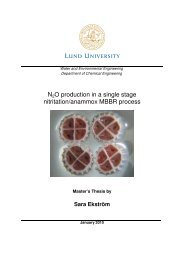Uran i dricksvatten â reningsmetoder i praktiken - Svenskt Vatten
Uran i dricksvatten â reningsmetoder i praktiken - Svenskt Vatten
Uran i dricksvatten â reningsmetoder i praktiken - Svenskt Vatten
You also want an ePaper? Increase the reach of your titles
YUMPU automatically turns print PDFs into web optimized ePapers that Google loves.
Summary<br />
A previous SVU-report (Ahlquist et al. 2007) concluded that anionic<br />
exchange and membrane technology were the most promising methods<br />
for removing uranium from drinking water. Pilot studies conducted in the<br />
municipalities of Uppsala and Enköping, and results from full-scale operations<br />
in the municipalities of Uppsala and Östersund also indicate that<br />
these methods are suitable. Based on these results, two additional pilot studies<br />
have been conducted which are presented in this report. The first study<br />
at Granbergsträsk Water Treatment Plant in the municipality of Skellefteå<br />
used two anionic exchange resins. The second study at Borrby Water Treatment<br />
Plant in the municipality of Simrishamn utilized reverse osmosis.<br />
The results from these pilot studies, combined with previous Swedish<br />
experience, show that anionic exchange and membrane technology using<br />
reverse osmosis are effective processes for removing uranium. Anionic<br />
exchange works well for water with different chemical properties and the<br />
same can be concluded for the adsorption method used in Östersund. If the<br />
membrane technology is used for hard water, it is important to either use an<br />
antiscalent before the water enters the reverse osmosis module, or to use a<br />
water softener to minimize the risk of limestone deposit on the membrane.<br />
When handling the resin as a waste product, uranium and its radioactive<br />
decay products must be taken into consideration. A safe working environment<br />
and a correct treatment of the produced waste have to be secured.<br />
At high levels of gamma radiation in drinking water, documentation of<br />
the radiation may be required. There are no requirements for continuous<br />
supervision of dosage if the annual dosage is below 1 mSv. The alpha radiation<br />
from the resin does not affect workers as long as the resin is intact and<br />
sealed. Particular precautionary measures in the working environment are<br />
generally not required. If the resin needs to be openly handled, standard<br />
working environment regulations are normally sufficient for radiation protection.<br />
At the Granbergsträsk Water Treatment Plant, with uranium levels<br />
of 20–40 µg/l and an anionic resin operating for 155 days without regeneration,<br />
there was no indication of raised gamma radiation outside the resin<br />
tank.<br />
The general principle regarding water containing low levels of naturally<br />
occurring uranium is that water used for rinsing, for example from regeneration<br />
or back-flushing, can be lead directly to the receiving body of water.<br />
If the used resin has a mean value above 10 kBq/kg (800 ppm) of uranium-238,<br />
a permit or exemption from the Swedish Radiation Safety<br />
Authority may be required, both for disposure as landfill and for transportation<br />
of the hazardous waste. Considering the waste management issue, the<br />
resin is preferably regenerated before it is disposed off. Analyses of the resins<br />
used in Skellefteå indicate that regeneration of the resin with a sodium<br />
chloride solution can reduce the load of uranium adsorbed in the resin by<br />
as much as 95 %. There are no indications of accumulated uranium in used<br />
membranes.<br />
7















